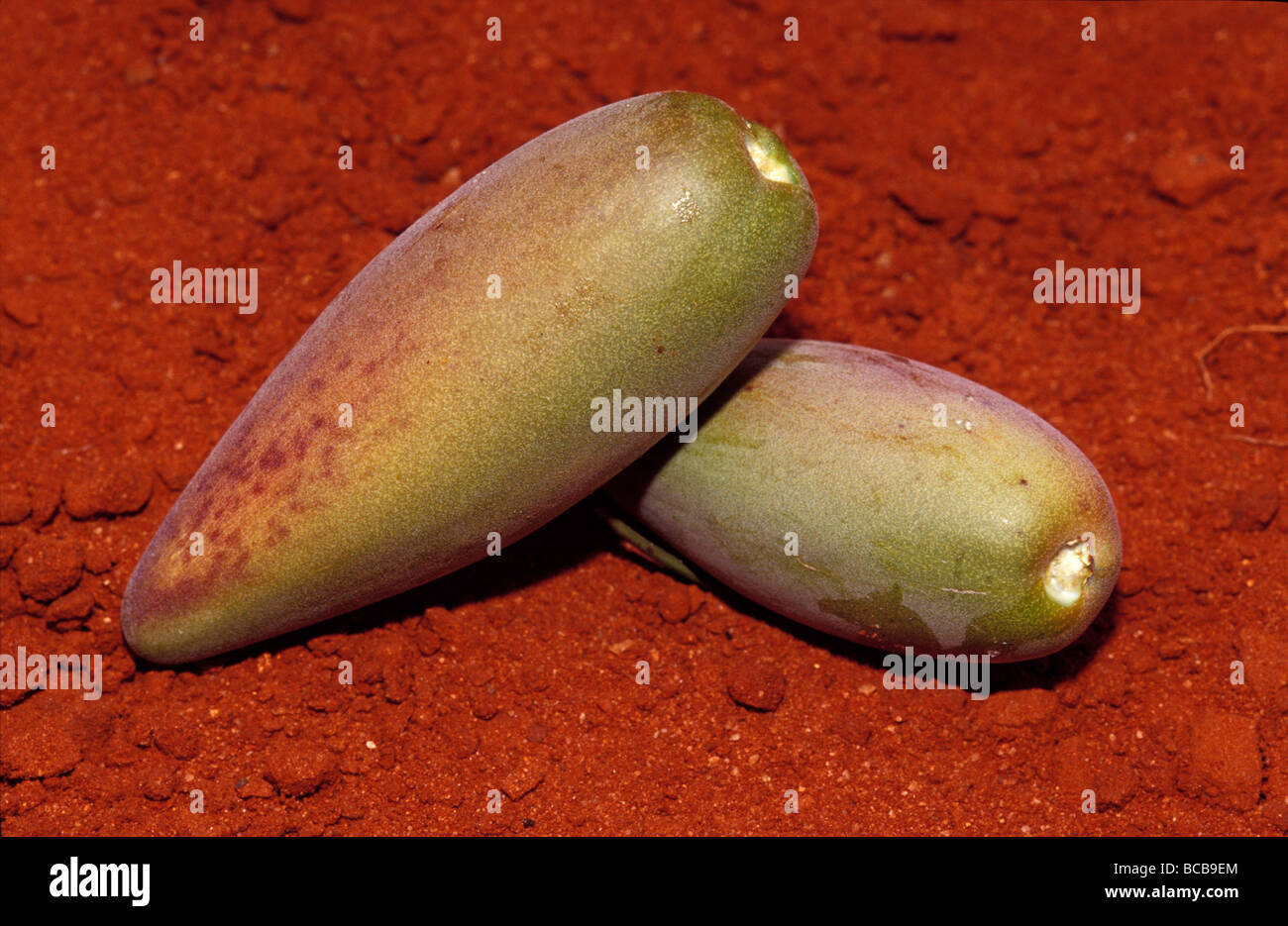
The Bush Banana: A Staple of Aboriginal Tradition and a Culinary Treasure
The vast and varied Australian landscape holds a wealth of natural resources, many of which have sustained Indigenous communities for tens of thousands of years. Among these, the humble yet vital "bush banana" stands out as a significant traditional food source, deeply woven into the cultural fabric and ecological knowledge of Aboriginal peoples across the continent. While not a banana in the botanical sense, this versatile plant, scientifically known as Solenostemon species (though often referring to various tuberous plants that share similar uses), has been a cornerstone of survival, sustenance, and cultural practice for millennia.
The term "bush banana" is a broad descriptor, encompassing several different tuberous plants that bear edible roots. These plants are indigenous to Australia and are found in diverse environments, from arid desert regions to more temperate woodlands. Their ability to thrive in harsh conditions speaks to the resilience and adaptability of both the plants themselves and the Aboriginal people who learned to identify, harvest, and prepare them.
A Glimpse into Ancient Sustenance:

For Aboriginal Australians, the bush banana was far more than just food; it was a reliable and nutritious resource that played a crucial role in their hunter-gatherer lifestyle. The tubers, typically harvested from underground, provided a valuable source of carbohydrates, offering essential energy for daily activities. Their nutritional profile also included other vital nutrients, contributing to the overall health and well-being of communities.
The process of finding and harvesting bush bananas was a sophisticated art, passed down through generations of knowledge. Elders and experienced hunters would possess an intimate understanding of the land, recognizing the subtle signs that indicated the presence of these tubers. This knowledge encompassed understanding the soil types, the seasonal growth patterns, and the specific characteristics of the plants that signified a mature and edible root. Often, specialized tools, crafted from natural materials, were used for excavation, ensuring minimal impact on the surrounding environment.
Cultural Significance and Traditional Practices:
The significance of the bush banana extends beyond its nutritional value. It is deeply embedded in Aboriginal storytelling, song, and ceremony. Many Dreamings (creation stories) feature the bush banana, illustrating its origin and its importance in the landscape. These narratives not only served to educate younger generations about the plant and its uses but also reinforced cultural values and spiritual connections to the land.
Traditional preparation methods were ingenious and varied, reflecting the specific resources and culinary traditions of different Aboriginal groups. One common method involved roasting the tubers directly in the ashes of a campfire. This slow roasting process not only cooked the starch but also imparted a distinct, often smoky, flavor. Another technique involved boiling the tubers, either in water or by wrapping them in leaves and placing them in a heated earth oven. Some preparations might have involved pounding or mashing the cooked tubers to create a smoother texture or to incorporate them into other dishes.
The harvest and preparation of bush bananas were often communal activities, fostering social cohesion and strengthening intergenerational bonds. Sharing the bounty of the land was a fundamental aspect of Aboriginal society, and the bush banana was a significant contributor to this collective sustenance.
Ecological Knowledge and Sustainable Harvesting:
The long-standing relationship between Aboriginal peoples and the bush banana is a testament to their profound ecological knowledge and their commitment to sustainable practices. They understood the delicate balance of the ecosystem and the importance of not over-harvesting. This ensured the continued propagation of the plants for future generations.

Methods like selective harvesting, leaving behind smaller tubers or immature plants, were likely employed. Furthermore, the understanding of the plant’s life cycle would have guided harvesting times, ensuring that seeds or runners were left to regenerate the population. This deep respect for the natural world and its resources is a hallmark of traditional Aboriginal land management.
Modern Relevance and Culinary Revival:
In contemporary Australia, the bush banana is experiencing a quiet but significant culinary revival. As interest in native Australian foods grows, so too does the appreciation for the unique flavors and nutritional benefits of these traditional ingredients. Chefs and food enthusiasts are increasingly exploring the potential of bush bananas, seeking to incorporate them into modern cuisine.
However, the integration of bush bananas into mainstream diets also raises important considerations. It is crucial that this revival is conducted in a way that respects the cultural heritage and traditional knowledge associated with these plants. Sustainable sourcing, fair trade practices, and collaboration with Aboriginal communities are paramount to ensuring that the benefits are shared and that the cultural significance is honored.
Challenges and Opportunities:
One of the challenges in widespread adoption is the inherent variability of bush banana species and their availability. Unlike commercially cultivated crops, their presence and abundance are dictated by natural cycles and environmental conditions. This makes consistent supply a hurdle for large-scale commercial ventures.
Despite these challenges, the opportunities are immense. The unique flavor profiles of bush bananas offer a distinct Australian culinary identity. Their potential as a healthy and sustainable food source aligns with growing global trends towards plant-based diets and a greater awareness of food security.
Furthermore, the cultivation and commercialization of bush bananas can provide economic opportunities for Aboriginal communities, empowering them to share their traditional knowledge and benefit from the resources of their ancestral lands. This can involve establishing community-managed farms, developing value-added products, and participating in the education and promotion of native foods.
The Future of the Bush Banana:
The journey of the bush banana from a staple of ancient sustenance to a potential ingredient in modern kitchens is a compelling narrative of resilience, cultural preservation, and culinary innovation. As we continue to explore and appreciate the diverse bounty of Australia’s natural heritage, the bush banana stands as a powerful symbol of the deep and enduring connection between Indigenous peoples and their land.
Its future lies in a harmonious balance between respecting its rich traditional past and embracing its potential for the future. By learning from the wisdom of Aboriginal peoples, we can unlock the culinary treasures of the bush banana, celebrating its unique flavors, its nutritional value, and its significant place in Australia’s cultural and ecological tapestry.
Bush Banana Recipes: A Taste of Tradition and Innovation
While specific traditional recipes are often passed down orally and vary greatly between Aboriginal groups, here are some conceptual recipes inspired by traditional preparation methods and modern culinary adaptations. It’s important to note that authentic bush banana preparation often involves specific knowledge of identifying edible species and safe cooking techniques.
Important Disclaimer: When attempting to cook with bush bananas, it is absolutely essential to ensure you are using correctly identified edible species and have received guidance from knowledgeable sources or Aboriginal elders. Some tubers can be toxic if not prepared correctly.
1. Roasted Bush Banana with Bush Tucker Spices
This method draws inspiration from traditional campfire roasting.
Ingredients:
- Freshly harvested bush banana tubers (ensure they are identified as edible)
- Olive oil or native macadamia oil
- A blend of native Australian spices (e.g., ground bush tomato, saltbush, wattle seed, lemon myrtle)
- Sea salt
Instructions:
- Preparation: Thoroughly clean the bush banana tubers, removing any soil. You can leave the skin on for roasting, as it can add flavor and nutrients.
- Scoring: Lightly score the skin of the tubers with a sharp knife in a criss-cross pattern. This helps the heat penetrate and the flavors to infuse.
- Seasoning: Drizzle the tubers with olive oil or macadamia oil. Rub the native spice blend and sea salt generously over the surface.
- Roasting:
- Traditional Method (Campfire): Wrap the seasoned tubers in large, damp eucalyptus leaves or a similar heat-resistant leaf. Bury them in the embers of a dying campfire and cook for 1-2 hours, or until tender.
- Modern Oven Method: Preheat your oven to 200°C (400°F). Place the seasoned tubers on a baking tray lined with parchment paper. Roast for 45-75 minutes, or until fork-tender. The cooking time will vary depending on the size of the tubers.
- Serving: Serve hot, either as a side dish or as a flavorful snack. The roasted flesh should be soft and slightly sweet, with a hint of smokiness and the unique aroma of the bush spices.
2. Creamy Bush Banana Mash
A comforting and versatile way to enjoy the tender flesh of the bush banana.
Ingredients:
- Boiled bush banana tubers (identified as edible)
- Native macadamia milk or coconut milk (unsweetened)
- A knob of butter or a drizzle of native oil
- Saltbush flakes (for seasoning, or use sea salt)
- Optional: finely chopped native herbs like lemon myrtle or native mint
Instructions:
- Boiling: Peel the boiled bush banana tubers (if they were boiled with skin on).
- Mashing: Place the boiled tubers in a bowl. Add butter or native oil. Mash the tubers with a potato masher or a fork until smooth.
- Adding Liquid: Gradually add native macadamia milk or coconut milk, a little at a time, stirring until you achieve a creamy, desired consistency.
- Seasoning: Stir in saltbush flakes or sea salt to taste. If using, gently fold in the chopped native herbs.
- Serving: Serve as a side dish, similar to mashed potatoes. It pairs well with roasted meats or as a base for other dishes.
3. Bush Banana Fritters
A delightful way to incorporate the slightly sweet and starchy bush banana into a more snack-like preparation.
Ingredients:
- Grated raw or lightly steamed bush banana tubers (identified as edible)
- 1/2 cup self-raising flour (or plain flour with a pinch of baking powder)
- 1 egg, lightly beaten
- A splash of native macadamia milk or water
- A pinch of sea salt
- A pinch of ground native pepperberry (optional, for a slight peppery kick)
- Native oil for frying
Instructions:
- Batter: In a bowl, combine the grated bush banana, flour, beaten egg, salt, and pepperberry (if using).
- Consistency: Gradually add native macadamia milk or water until you have a thick batter consistency, similar to pancake batter.
- Frying: Heat a generous amount of native oil in a frying pan over medium heat.
- Cooking: Spoon tablespoons of the batter into the hot oil, flattening them slightly. Fry for 2-3 minutes per side, or until golden brown and cooked through.
- Draining: Remove fritters from the pan and drain on paper towels.
- Serving: Serve hot. These can be enjoyed on their own, with a dollop of native bush tomato chutney, or as a savory accompaniment.
4. Bush Banana and Native Greens Stir-fry
A vibrant and healthy dish showcasing the versatility of the bush banana.
Ingredients:
- Thinly sliced bush banana tubers (identified as edible, can be lightly par-boiled if preferred)
- A mix of native greens (e.g., warrigal greens, river mint, native spinach)
- Thinly sliced native onion or shallots
- Garlic, minced
- Ginger, grated
- Native oil for stir-frying
- A dash of native soy sauce or tamari
- A squeeze of finger lime juice (for brightness)
Instructions:
- Preparation: Prepare all your ingredients before you begin stir-frying, as it cooks quickly.
- Sauté Aromatics: Heat native oil in a wok or large frying pan over medium-high heat. Add the native onion or shallots, garlic, and ginger. Stir-fry until fragrant.
- Add Bush Banana: Add the sliced bush banana to the pan. Stir-fry for 2-3 minutes until it starts to soften slightly.
- Add Greens: Add the native greens and stir-fry until they wilt, about 1-2 minutes.
- Seasoning: Drizzle with native soy sauce or tamari.
- Finishing: Add a squeeze of finger lime juice just before serving for a burst of citrus.
- Serving: Serve immediately, perhaps with a side of native grain rice.
These recipes offer a starting point for exploring the culinary potential of the bush banana. Remember to approach these ingredients with respect for their cultural significance and with a commitment to learning from traditional knowledge.

